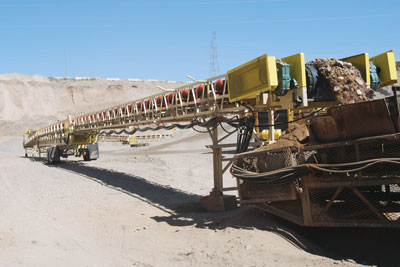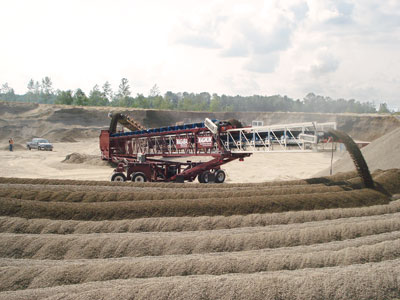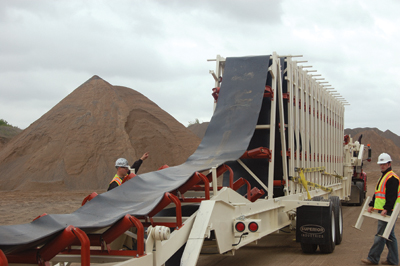
Products & Equipment
Pits & Quarries
Conveyor Systems Update
New offerings are bigger and faster, with features that make them more customized and adaptable
June 15, 2012 By Treena Hein
More than ever before, aggregate and roadbuilding companies are looking
for systems and solutions that allow them to better handle ongoing
operational challenges
More than ever before, aggregate and roadbuilding companies are looking for systems and solutions that allow them to better handle ongoing operational challenges – and conveyors are no exception. Conveyor and conveyor accessory-makers are keeping pace by meeting industry requirements through user-friendly design features that help boost efficiency. “Rising fuel costs over the last several years have significantly contributed to increased demand for conveyor systems,” notes Joe Elmes, president at Masaba Canada Corporation. “As companies look at ways to cut operational costs and improve the bottom line, conveyor systems continue to become larger and more customized to meet specific consumer needs.” These needs include increased tonnage and adaptable equipment that can fit within existing systems, says Elmes.
 |
|
| The ability of the 225-foot Overland Conveyor to pivot at its connection points allows it to adapt to curve in the terrain. |
“Generally speaking, during the last decade, customers are requesting conveyor systems that are longer, wider and faster,” notes Bob Domnick, vice-president of engineering at Superior Industries. “Conveyor systems are also getting more reliable and more maintenance-friendly.” For example, 10 years ago, the standard size of a Superior TeleStacker conveyor was 36 inches wide by 150 feet long. Those units stockpile material at about 800 to 1,000 tons per hour (TPH). At that time, the company says, it had only manufactured one of the telescopic radial stacking conveyors wider than 36 inches.
Skip forward 10 years and Superior reports that in 2010 and 2011, more than 30 percent of their TeleStacker conveyors were designed with belts wider than 36 inches. That means production rates are increasing at these sites to at least 1,200 TPH and often more. Late in 2010, Superior completed work on the world’s largest-ever telescopic radial stacking conveyor, a 72-inch-wide by 190-foot-long model that unloads construction aggregates from ships at a whopping 5,000 TPH. Then, in 2011, Superior introduced the Trailblazer Conveyor, a 500-foot groundline conveyor that’s towable and allows deployment from the road to working status in about an hour. It folds in or out easily in accordion fashion with a minimal crew required to position the supports.
 |
|
| MASABA’s patented “Track Technology” featured on the Magnum Telescoping conveyor provides constant positive traction and smoother stinger operation, both of which result in improved long-term durability. |
“We like to compare the Trailblazer Conveyor to a grouping of jump/grasshopper/transfer conveyors,” says Domnick. “Systems of this length typically include as many as eight separate jump conveyors, which means a lot of maintenance time for things like tracking the belts and cleaning transfer points. The Trailblazer has one transfer point, one power supply and one belt.” The 36-inch-wide belt unit features two 25 hp 1800 RPM TEFC (totally enclosed fan-cooled) motors, a capacity of 1,000 STPH (standard tons per hour) of 100 PCF (pounds per cubic foot) material and a belt speed of 400 fpm. “You can turn up the speed or slow down the speed of your belt just by turning a knob,” notes Domnick. “Traditionally, you’d need to rely on changing the gear boxes or shive ratios – not very convenient.”
Conveyor accessory manufacturer Flexco has also put an emphasis on developing products that are more efficient and faster than ever to install and maintain. “We also try to make sure that the product is compatible with the other components of a conveyor system, keeping in mind that the system should function holistically,” says director of marketing (heavy duty) Chip Winiarski. “One of the keys to keeping an operation running efficiently involves being proactive. We encourage aggregate operations to consider a yearly conveyor audit in which the system is looked at as a whole. This will often identify challenges before they become problems.”
Flexco’s new BR rivet solid plate fastener was developed specifically for straight-warp carcass belting, he notes. “The staggered, multi-point attachments penetrate between carcass fibres without severing them,” Winiarski explains. “This feature delivers long-lasting holding ability in even the most demanding high-tension applications.” Flexco’s BR6 is a smaller plate fastener, ideal for small pulley diameters, says Winiarski, with the same benefits as a larger fastener. “The BR6 only requires a hammer or power rivet driver and our portable MBRT tool to align and drive in the rivets,” he notes.
Flexco also now offers the PT Smart belt trainer, which corrects belt mistracking with medium-duty tensioned belts. “The PT Smart applies greater belt tracking discipline than conventional pivot-only or wobbler belt-steering devices, correcting even the most stubborn tracking problems,” Winiarski says.
 |
|
| The 500-foot Trailblazer Conveyor has one transfer point, one power supply and one belt . . . drastically reducing the time needed to maintain all of those transfer conveyors. |
Martin Engineering’s outlook on conveyor design emphasizes clean, safe, and productive material handling with components that resist dust accumulation, says marketing specialist Chelsea Blake. The company has recently opened a new 22,600-square-foot “Center for Innovation” where staff can collaborate with customers, academics, and others from around the world to analyze and test system and component performance. “For example, we continue to study how our new EVO components perform,” says Blake. “These parts have an angled design so that they easily shed dust and material, helping reduce buildup underneath the conveyor structure and the hazards associated with manually cleaning fugitive material.” EVO components are also track-mounted, she notes, which improves ease of maintenance and installation while increasing safety for workers.
Martin’s Sonic Horns also aid in increasing productivity and efficiency. “The horns generate and magnify low-frequency, high-pressure sound waves, which cause dry particulate buildup to resonate and fluidize, allowing the material to be removed from the vessel by constant gas flow or gravity,” says Blake. “The acoustic cleaners are effective around pipes and inaccessible parts without creating structural fatigue or damage.” Blake says the horns also improve the effectiveness of catalysts and prolong the lives of catalysts and equipment, in addition to helping companies comply with emissions regulations.

|
|
| Martin’s Sonic Horns aid in dealing with dust safely and efficiency by generating and magnifying low-frequency, high-pressure sound waves that cause dry particulate buildup to resonate and fluidize. This allows particulates to be removed by constant gas flow or gravity.
|
Fisher Industries manufactures all types of conveyors, from Extenders and Radial Stackers, to a Five-Pack conveyor system. “The newest design of our 225-foot Overland Conveyor reduces both mobilization time and costs because it’s so easy to transport, set up, and tear down,” says sales manager Curt Kittelson. “It’s designed with the mobile contractor in mind, with a heavy-duty truss-style frame and the ability to pivot at its connection points, which allows it to adapt to vertical curves in the terrain.”
The Overland also requires very little training, Kittelson says. “In addition, because it’s one conveyor compared to multiple pieces, this lessens potential material breakdown that often results from having multiple transfer points,” he notes. The Overland is designed to operate 1,000 tons per hour at 390 feet per minute.
With its newest telescoping conveyor offering, Masaba has replaced the traditional winch and cable system with a track system to extend and retract the stinger conveyor. “Masaba’s patented “Track Technology” featured on our Magnum Telescoping conveyor provides constant positive traction and smoother stinger operation, both of which result in improved long-term durability,” says Elmes. “Track technology eliminates cable maintenance issues associated with traditional winch systems, and eliminates the danger of cable breakage and uncontrolled rollback.”
The Magnum also features a “Swing Axle Undercarriage System,” which Elmes says provides the widest, most stable footprint in the industry. “In addition, Masaba’s variable speed two-wheel drive system (four-wheel drive also available) allows even distribution of material in pile for higher-quality desegregated piles,” he notes. “The Magnum also has the most user-friendly PLC (programmable logic controller) on the market, with a ton of benefits, including four customizable programs that enable customers to choose their stockpiling preference.” Over the last five years, Masaba has established a distribution network to support customer needs and will continue to focus on enhancing this area of the business.
Print this page